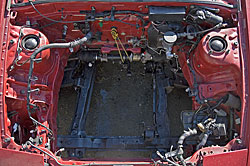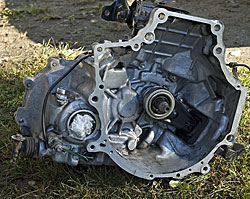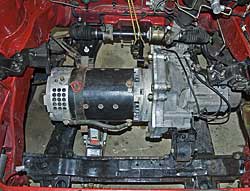You will find articles organized by categories, along with recent comments, along the right hand column of the website. If you are just getting started with the idea of converting a gas car to electric be sure to check out Your First Electric Car
Welcome and enjoy!
-Jerry
Clean Start · 7 October 05

It may not be one of the universal truths, but when venturing into a new project you should always consider which new tools you’ll be able to get away with justify buying.
This truth became self evident when I checked out the price of renting a pressure washer. For another eighty bucks I could buy a brand new one. That’s exactly what I did, picking up a 1750psi electric pressure washer and a couple cans of engine cleaning solvent.
Time to do battle…

I decided on electric mostly because I’m tired of accumulating little gas powered gizmos that sit around the garage oozing oil and gas, make a god-awful noise to operate, and slowly beat themselves to death. We switched to a battery powered weed whacker a couple years ago and a little battery powered push mower earlier this year.
Commercial battery powered gizmos are usually on the weak side. It’s not that they can’t make beefier equipment, I think it’s more of a matter of price and weight. Higher density batteries are more expensive and might require additional charging and safety circuits. Heavy duty motors and the batteries to run them make for more weight to lug, which most weekend weed whackers aren’t going to appreciate. Just keep this in mind if you buy one and get an extra battery.
But I’m getting a little off topic…
So, yeah, I bought an electric pressure washer and a couple spray cans of some non-toxic engine degreaser. Pushed Eve out onto the driveway, lugged the transmission out with her, and covered them both with a blast of cleaner spray. Fired up the pressure washer, got out the dirty rags, and went to town cleaning off fifteen years of accumulated crud.

Hey, how about that? Eve looks pretty good once she’s cleaned up! Check out the before shot.

Without the motor, transmission, gas, or exhaust system in place Eve is pretty easy to push in and out of the garage. While she was out warming up and drying in the New Hampshire Fall Sun I cleaned up the garage a little bit and set about piecing together the drive train.
Notice how nice the transmission looks? Here’s the before shot for comparison. After taking the photo I removed the clutch throwout bearing and yoke (thanks Dan) along with the hydraulics. I don’t use a clutch in the EV, shifting is rare enough that it’s just not worth messing with it.
As you can see in the image at the top of this article (click images for much larger version) the Advanced DC electric motor mounts perfectly to the transmission using the old adaptor plate. I can’t begin to say how great that is! Thanks again to Ryan who clued me in to the common transmissions.
Got out the come-along, heavy duty nylon straps, and lifted the whole assembly high enough to slip Eve underneath. This is where using a real engine hoist would be better as you’d just move the hoist around for positioning. Instead I got to move Eve around to line up with the motor-transmission.
Like I said, glad she’s lighter and relatively easy to move around.

There you have it, electric motor and transmission in place. The motor mounts aren’t all hooked up yet as I might still have to remove the whole setup again before the project is over. I also have to fabricate a hunk of metal to connect the end of the electric motor to the wheel well on the left. You can see that I have the old mount kind of just sitting there, but it’s not attached to the motor yet.
While I was cleaning the engine I also removed some more unneeded components. Stripped out the rest of the power steering hosing and brackets, will need to get/make plugs for the old hose connections. Also removed a whole bunch of random mounting brackets; what with all of the wires and hoses going to/from the engine it seems they had an extra bracket on almost every surface.
Take a look at the large view of the cleaned engine compartment earlier on the page. See that huge rat tail of wire coming out of the firewall? That’s the fuel injector wire bundle, most likely leading into an onboard computer. Along with that is another bundle heading to relays on the right. The only relay that seems useful is for the horn, which means I ought to be able to yank out ALL of those wires.
On the first EV I started pulling apart a wiring harness one weekend and almost started down the path of rewiring the whole car. It’s hard to describe how much electronics are involved with the average gas powered automobile engine. It makes the average electric car look almost primitive. All of that stuff is now excess weight and mess. We’ll see if I can resist the urge to organize.



Nice progress – Eve’s looking good.
I know this is premature, but here’s a decent source for paint:
www.paintforcars.com (no, I’m not affiliated with them, but they’ve got great prices).
On a much more related note, I definitely understand what you’re talking about with the battery powered weed eaters. My wife and I went through three of them before finally finding one that will last more than a month.
And for the mower… why not skip power completely? Push reel mowers aren’t nearly as annoying as they once were!
I’ve always known the parts you refer to as the “throwout bearing” and the “yoke.”
There are pros of having a “real engine hoist” (or shop crane as they’re also called) are mostly about having a single hydraulic fixture with which you can lift an engine/tranny assembly out of a car and move it across the shop. You usually have to move the car some anyway. My shop crane has wheels that are small and metal, and require a smooth, level and very hard surface on which to roll. You have to be vigilant not to hit some debris and tip the thing over (yikes).
The come-along approach always favored the “shade tree” mechanic who could roll a car under a tree, lift the engine out and roll the car away in order to work on the engine. The car’s large rubber tires can actually roll on the irregular ground beneath the tree where the grass is sometimes greener. :)
Thanks for the link, Rob. Yes, paint is in our future although I totally, absolutely, positively, hate painting so I’ll be farming that job out to someone else.
Thanks for the right words Dan, should have consulted the shop manual. And, yes, I am a shady mechanic… ”:^)
Jerry, Looking good.
As far as the steering is concerned, you may want to “loop” the pressure and return hoses and make sure the rack & pinion is full of ps fluid too. It may not be neccesary but I’ve allways wondered if plugging the fitting ports would cause it to lock hydraulicly. I may be wrong though.
Also, do you have on the website a listing of EV parts suppliers ? Thanks, Greg
Man! It’s very tempting to tear into my Probe! It however is not first on the list of vehicles to be converted.
Could you flip the engine-side motor mount over so that the mount came closer to the end of the motor? Would that locate it better than where currently is? Or are you thinking of un-bolting the end of the mount from the isolator and fabricating a new one?
I notice that your transmission input shaf has a pilot snout on it that would line up with pilot bushing in the end of the crankshaft in an ICE unit. How do you support it on the electric motor? My Yugo didn’t have the pilot portion of the shaft so I didn’t have to contend with it.
Glad to see the progress.
Thanks for the tip Greg G.
Kendall, somewhere in the mess I call “garage” is the old mount from the Mazda which was fabricated from a huge slab of aluminum (and mounted from the bottom). I’m kind of hoping it won’t take much to retrofit it, but then again I’m always optimistic. Failing that I may follow Shaun’s lead since his mount looks similar.
Greg C.: Pilot snout…wha??
Not using your power steering? Did you change gear ratio’s? Did you do this with your first EV; if so, how hard did it steer? Considering what to do with my Nissan Conversion.
Hi Woody,
On the first EV I removed the hydraulics and looped the two stubs back to each other. It was a little stiff to turn the wheel if at a dead stop, but overall neither my wife or I had any problems driving it.
Didn’t touch the gears.
Power steerig… had a mechanic suggest converting one end to a greese fitting and leave the other with a small opening. Removes any backpressure and keeps it lubed, but would require regular greesing.
Another interesting idea, thanks Woody.
The backpressure thought gave me this odd idea:
Run a tube from each side into the passenger compartment. Hook them up to some sort of clear tube. As you steer, the oil/grease (with a bubble or two for fun) squirts back and forth!
Kind of like a retro prop from the Terry Gilliam movies Brazil or 12 Monkeys.
Hi Jerry, I noticed you removed your clutch essentials due to a lack of gear changes. Could you still change gear, say, if your foot is off the ‘gas’.
Hi from Downunder Jerry – enjoying your conversion thoroughly!
Hi Gavin,
Yes, we shift up exactly as you describe. Typically we didn’t down shift until at a light, or going slow enough that it made sense.
p.s. does that make us “up-over”?
Jerry – a shifting question for you…
Without a clutch, could you for example, pop the gear selector into neutral to coast down a hill (removing the extra drag of the spinning motor), and then easily re-engage the same gear to continue driving after coasting?
Absolutely. We live at the top of a mile long hill. Once out of the driveway and on the road we pop it out of gear for the rest of the way down the hill (another route has some uphill first and then all downhill). There’s stop signs at the bottom of each hill and that’s when we re-engage the gear.
Now let’s say there was no stop at the bottom. Do you have to wait until stopped (or nearly so) to re-engage a gear, or would the transmission permit you to re-engage on the fly?
(I suspect the motor would need to be already turning at the appropriate RPM for the gear you want to use in order to re-engage on the fly…)
It varies. Sometimes you can get it to pop right into gear (with a little pressure) other times a slight bump to the accelerator spins things up for better syncing.
It’s a lot like up-shifting except the DC motor isn’t turning. You give the motor a little juice, it spins up, and then applying pressure to shifter it will “click” into place as the speed/gears sync. Sounds more complicated than it is but it works fine.
I seldom had to do this. For some odd reason all of the hills in this town culminate in either:
All of which makes for some thrilling winter driving.
Thankyou for your answer. As a result I have procured a forklift truck motor and contactors and controller a Prestolite 6 5/8” Diameter motor and GE ev1 controller. Where can I get information on putting it alltofgether
Thankyou for your answer. As a result I have procured a forklift truck motor and contactors and controller a Prestolite 36 volt 6 5/8” Diameter motor and GE ev1 controller. Where can I get information on putting it all together
I had what i thought was a hair brained scheme after watching a few episodes of cool fuel on discovery, I noticed all the ev were directly driven. i was wondering if say a toyota tacoma could possibly be run through it’s old transmission or if i would have to run it direct. I think that I have found my answer. I do think however I will have to do more research to see if this can be done with an automatic. I thought it could be done considering at 65 mph my 4 cylinder engine only turns at 2500 rpms that i might tax the batteries less and get more milage from the vehicle. you definatly have inspired me to try this myself.
Donald, Did you ever find the manual on the GE EV1 Controller. I could use some help.
jbartlett1@yahoo.com
Slip Shifting is a term used in the Over The Road Trucking industry. most truckers use the clutch for initial rolling gear use only. After they are rolling, changing gears is only a matter of matching engine speed to tranny input shaft speed and is a learned technique. Reason… to extend life of clutch. Not having a clutch insures a driver would have to learn this way of shifting. Trust me, after a week of doing it YOU WILL BE ABLE TO MASTER IT. It is not difficult to do once you understand syncronicity of motor vs tranny. I did a street rod conversion on a 62 Ranchero and installed a rack & Pinion from a Honda and I connected power steering hose connections to each other and filled sytem with ps fluid. Capping the lines will cause pressure build up in the end cyllenders causing difficult steering. Would not want that in an emergency
Over the road trucks, or most heavy trucks for that matter have un-syncronized transmissions. So the must either be double cluched or slip-shifted. Standard automotive transmissions have syncronizers that WILL wear out much fasted when sifted without the clutch, Electric or not…